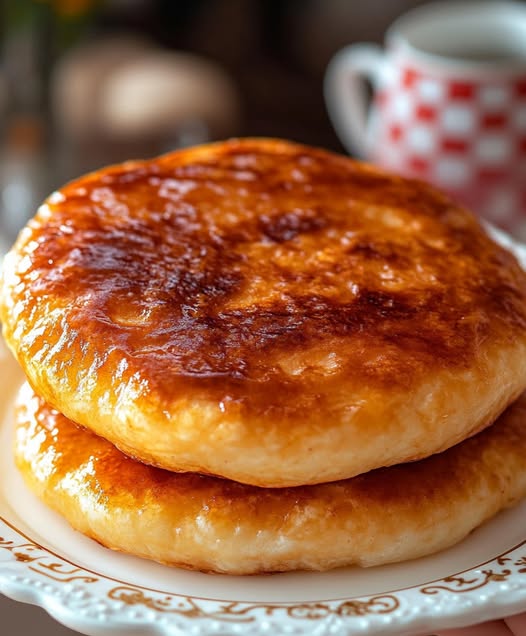Fluffy Oat Greek Yogurt Cakes

There’s something magical about achieving bakery-quality results with minimal ingredients. These fluffy, golden oat cakes combine the heartiness of oats with the richness of Greek yogurt to create a protein-packed breakfast or snack that’s both satisfying and simple. The best part? No flour needed! These pillowy soft French-inspired pastries require just three base ingredients but deliver incredible texture and flavor. Perfect for busy mornings or when you’re craving something homemade without the fuss.
Ingredients
For 2 individual cakes (10 cm/4-inch diameter):
- 30g (⅓ cup) rolled oats, ground to powder
- 130g (½ cup) Greek yogurt
- 1 large egg, lightly beaten
Optional add-ins:
- 30g (¼ cup) milk chocolate chips
- Or substitute with: raisins, chopped dates, fig pieces, or chopped nuts (walnuts, hazelnuts)
Instructions
- Prepare the oats: Grind 30g of rolled oats into a fine powder using a food processor or blender. Transfer to a mixing bowl.
- Add wet ingredients: Add 130g Greek yogurt to the bowl with the ground oats. The yogurt adds moisture and acts as a binding agent, replacing the need for traditional ingredients like flour and butter.
- Incorporate the egg: Add one lightly beaten egg to the mixture.
- Mix gradually: Stir the ingredients together slowly, allowing the oat powder to fully absorb the wet ingredients. Continue mixing until you achieve a thick, creamy, and slightly sticky batter.
- Add optional mix-ins: If desired, fold in chocolate chips or your chosen alternative (dried fruits or nuts).
- Prepare the molds: Line two 10 cm (4-inch) diameter baking molds or ramekins with parchment paper.
- Fill the molds: Divide the batter evenly between the prepared molds.
- Bake: Choose one of these cooking methods:
- Air fryer: Cook at 170°C (340°F) for 18 minutes
- Conventional oven: Bake at 170°C (340°F) for 20-25 minutes, until golden brown on top and cooked through
- Cool slightly: Allow the cakes to cool for 5-10 minutes before serving.
Nutritional Information and Timing
Preparation time: 5-7 minutes Cooking time: 18-25 minutes (depending on method) Total time: 25-32 minutes Servings: 2 individual cakes
Nutritional information (per cake, without optional add-ins):
- Calories: Approximately 170 kcal
- Protein: 12g
- Carbohydrates: 15g
- Fat: 7g
- Fiber: 2g
- Sugar: 4g (naturally occurring)
These cakes make an excellent high-protein breakfast option with balanced macronutrients.
Cooking Tips and Tricks
- Grinding oats: For the best texture, grind the oats until they resemble a fine flour. This ensures a smoother cake consistency.
- Yogurt selection: Full-fat Greek yogurt produces the best results, creating a moist, tender crumb. The higher protein content also helps with structure.
- Even cooking: For perfectly even browning, rotate your cakes halfway through the baking time.
- Testing doneness: Insert a toothpick into the center—it should come out clean or with a few moist crumbs attached, not wet batter.
- Let them rest: These cakes benefit from a short 5-minute rest after baking, which allows the structure to set and makes them easier to handle.
Variations and Substitutions
- Yogurt alternatives: If Greek yogurt isn’t available, try well-drained regular yogurt, fromage blanc, or mascarpone cheese.
- Flavor enhancements: Add 1 teaspoon of vanilla extract or ½ teaspoon of cinnamon for additional flavor.
- Savory version: Create a savory variation by omitting any sweetness and adding 2 tablespoons of grated cheese and herbs.
- Protein boost: Mix in 1 tablespoon of protein powder (vanilla or unflavored) for additional protein.
- Sweetener options: For a sweeter cake, add 1 tablespoon of honey or maple syrup to the batter.
- Vegan adaptation: Replace the egg with a flax egg (1 tablespoon ground flaxseed mixed with 3 tablespoons water, allowed to gel for 5 minutes) and use plant-based yogurt.
Frequently Asked Questions
Can I make these cakes gluten-free?
Yes! These cakes are naturally gluten-free when made with certified gluten-free oats. Always check packaging to ensure no cross-contamination if you have celiac disease or severe gluten sensitivity.
How do I know when the cakes are fully cooked?
The tops should be golden brown and spring back when lightly pressed. A toothpick inserted into the center should come out clean or with a few moist crumbs.
Can I make a larger batch?
Absolutely! Simply multiply the ingredients proportionally. For a larger cake, increase the baking time by 5-10 minutes and check for doneness.
Why didn’t my cakes rise much?
These flourless cakes won’t rise as dramatically as traditional flour-based recipes. Their texture is naturally denser and moister, similar to a cross between a cake and a baked oatmeal.
Can I freeze these cakes?
Yes, they freeze well for up to 3 months. Wrap individually in plastic wrap and place in a freezer bag. Thaw overnight in the refrigerator and warm briefly before serving.
Storage and Make-Ahead Tips
Counter storage: Store in an airtight container at room temperature for up to 2 days.
Refrigerator storage: Keep refrigerated in an airtight container for up to 5 days. The cakes may firm up slightly when chilled.
Freezer storage: Wrap individual cakes tightly in plastic wrap and place in a freezer bag. Freeze for up to 3 months.
Reheating: Warm refrigerated cakes in a microwave for 15-20 seconds or in a preheated 150°C (300°F) oven for 5 minutes. For frozen cakes, thaw overnight in the refrigerator before reheating.
Make ahead option: Prepare the batter up to 24 hours in advance and store covered in the refrigerator. Allow the batter to come to room temperature for about 15 minutes before baking.
These delightful three-ingredient wonders redefine what’s possible with minimal ingredients. Whether you call them cakes, breakfast pastries, or create a new name altogether, they’re sure to become a regular in your quick and healthy recipe rotation!
